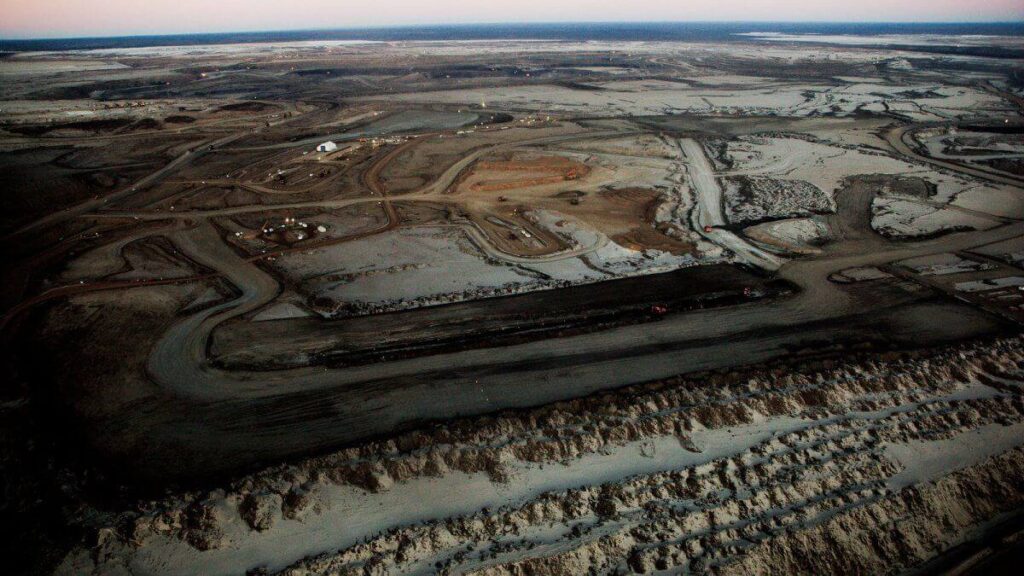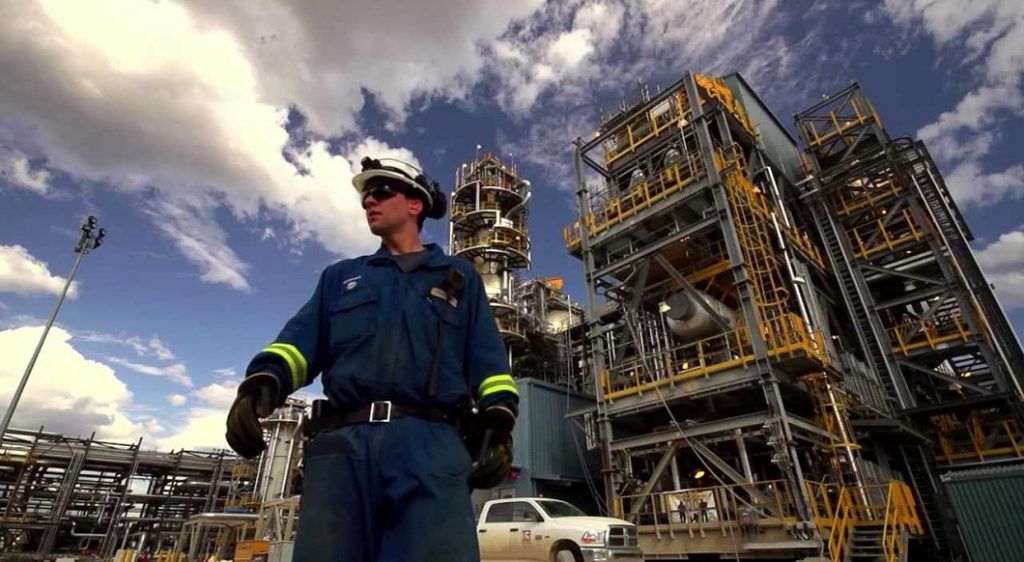Alberta’s Oil Sands Industry
The oil sands industry in Alberta, Canada, has become an essential contributor to the country’s economy in recent years. The industry’s vast reserves have made Canada one of the world’s largest producers of oil, and oil sands have been a significant driver of this growth. Here, we will provide an overview of the industry’s location, production and development, environmental and social impacts, and construction industry in Alberta.

Location and Map of Oil Sands Projects
The oil sands are located in northeastern Alberta, with the majority of the resource concentrated in three main areas: Athabasca, Cold Lake, and Peace River.
Several companies have oil sands projects in the region, with many providing maps of their specific sites. Suncor Energy’s Firebag project, Athabasca Oil Sands project, and Kearl Oil Sands project all have detailed maps available. Other maps include the Fort Hills project, Syncrude site, Alberta Tar Sands, Alberta Oil Sands, Alberta Oil Sands Lease, and Oil Sands Lease.
The following are some maps of the various oil sands projects in the region:
| Map | Project |
|---|---|
| Athabasca Oil Sands map | Athabasca Oil Sands |
| Athabasca Hangingstone map | Athabasca Hangingstone |
| Kearl Oil Sands Project map | Kearl Oil Sands Project |
| Alberta Tar Sands map | Alberta Tar Sands |
| Alberta Oil Sands map | Alberta Oil Sands |
| Alberta Oil Sands Lease map | Alberta Oil Sands Lease |
| Oil Sands Lease map | Oil Sands Lease |
Oil Sands Production and Development
| Year | Production (barrels per day) |
|---|---|
| 2016 | 2.3 million |
| 2017 | 2.6 million |
| 2018 | 2.8 million |
| 2019 | 3.0 million |
| 2020 | 2.5 million |
| 2021 | 2.7 million |
| 2022 | 3.2 million (estimated) |
The development of the oil sands industry in Alberta dates back to the early 1900s, with the first commercial production occurring in 1967. Since then, the industry has grown significantly, with production increasing from 2.3 million barrels per day in 2016 to 3.0 million barrels per day in 2019 before dropping to 2.5 million barrels per day in 2020.
The Oil Sands 2014 report provides a comprehensive overview of the industry’s history, production statistics, and future outlook. The report was prepared by the Canadian Energy Research Institute, an independent research organization.
The industry is dominated by a few major players, including Suncor Energy, Canadian Natural Resources Limited, and Imperial Oil. These companies operate large-scale mining and extraction operations and are investing in new technologies to improve the sustainability of the industry.
Upgraders and refineries in the region play a crucial role in the industry’s development. Upgraders convert bitumen extracted from the oil sands into a form that can be transported via pipelines, while refineries process the bitumen into petroleum products such as gasoline, diesel, and jet fuel.
According to the Canadian Association of Petroleum Producers, the production of oil sands in Alberta has fluctuated in recent years. In 2021, the production was approximately 2.7 million barrels per day, an increase from the previous year. However, this was still lower than the production levels in 2019.
In 2022, the production of oil sands was expected to increase further, with some projections estimating production of up to 3.2 million barrels per day. This increase in production can be attributed to the recovery of oil prices and the increasing demand for oil and gas globally.
Main Oil Sands Companies in Alberta
Oil Sands Developers Group
The Oil Sands Developers Group (OSDG) is a non-profit organization that represents the interests of oil sands producers in Alberta. The group’s mission is to promote responsible and sustainable development of the oil sands while providing economic benefits to the region and respecting the environment and local communities.
The OSDG works with government agencies, industry stakeholders, and community groups to develop policies and practices that support responsible development. The group also provides a forum for members to share best practices and collaborate on solutions to common challenges.

Some of the key initiatives of the OSDG include promoting the use of innovative technologies to reduce greenhouse gas emissions and improve environmental performance, supporting research and development of new oil sands extraction methods, and engaging with Indigenous communities to ensure their concerns and interests are taken into account in oil sands development.
Suncor
Suncor is an integrated energy company headquartered in Calgary, Alberta. Its operations include oil sands development, production and upgrading; offshore oil and gas; petroleum refining in Canada and the US, and its Petro-Canada retail distribution network.
Suncor’s oil sands operations include the Base Plant, Firebag, and Fort Hills projects in the Fort McMurray-Wood Buffalo region. The company is focused on responsibly developing petroleum resources while advancing the transition to a low-emissions future. Suncor is one of the key oil sands producers in the area and plays a significant role in the Fort McMurray oil sands companies network.
Canadian Natural Resources Limited (CNRL)
CNRL is a Canadian independent energy company engaged in the acquisition, exploration, development, production and sale of crude oil, natural gas liquids (NGLs), and natural gas.
The company is a major player in Alberta’s oil sands, with operations including the Horizon Oil Sands project, Northwest Bitumen Upgrader, and the Grouse and Kirby In Situ Oil Sands Projects. In 2013, CNRL’s net earnings totalled $2.3 billion, with oil sands production of approximately 133,000 barrels per day. As a leader among oil sands producers, CNRL has a prominent presence in the Fort McMurray oil sands companies community, contributing to the regional and national economy.
Oil Sands Alliances, Alberta
Pathways Alliance
Formed in June 2022 from the merger of the Oil Sands Pathways to Net Zero Alliance and COSIA. Its goal is to achieve net-zero emissions from oil sands operations by 2050. Members include 6 major oil sands producers in Canada.
Key focus areas are developing carbon capture and storage, reducing environmental impacts, and collaborating with communities and governments.
Regional Oil Sands Operating Alliance (ROA)
Founded by Cenovus Energy in 2017 to unite oil sands companies and improve competitiveness and sustainability.
Key initiatives relate to sharing innovative technologies, supply chain collaboration, benchmarking, and health and safety. Helped coordinate critical pandemic response for the industry.
Canada’s Oil Sands Innovation Alliance (COSIA)
Launched in 2012, it includes 13 member companies representing over 90% of Canada’s oil sands production.
Focused on accelerating environmental performance improvement in 4 priority areas – greenhouse gases, land, water, and tailings. Mobilizes collaboration between industry, government, academia and the public.
Key projects include the NRG COSIA Carbon XPRIZE competition and the Environmental Technology Assessment Portal (E-TAP) to source new technologies.
Environmental and Social Impact
The oil sands industry has been the subject of significant environmental and social concerns, with some calling for the industry’s development to be halted altogether.
Water Usage and Contamination
Water is a crucial component in the oil sands extraction process, with large amounts used in both surface mining and in-situ extraction methods. The industry is a major consumer of freshwater resources, which has led to concerns about the impact on local water systems.
Tailings ponds, which store the wastewater produced during extraction, have also been linked to water contamination. These ponds can contain a range of pollutants, including heavy metals and chemicals, which can seep into nearby rivers and groundwater.
Social Impacts on Nearby Communities
Oil sands development has also had social impacts on nearby communities. The rapid growth of Fort McMurray, the hub of oil sands development, has put a strain on local infrastructure and services. The use of FIFO (fly-in fly-out) workers has also led to concerns about the impact on local communities, with some arguing that it has contributed to a lack of local jobs and a transient workforce.
Indigenous communities, such as the East Prairie and Peavine Metis settlements, have also been impacted by the oil sands industry. There have been concerns about the impact on traditional land use and the potential for negative health impacts due to air and water pollution.
Impact on Wildlife and Ecosystems
The development of the oil sands has also had a significant impact on the surrounding wildlife and ecosystems. Habitat destruction and fragmentation have led to a loss of biodiversity, while migratory bird populations have been affected by the development of the industry.
Greenhouse Gas Emissions
The oil sands industry is a significant contributor to greenhouse gas emissions, with some estimates suggesting that it produces up to four times more emissions than conventional oil production. The industry has committed to reducing emissions through the use of new technologies and carbon capture and storage methods, but progress has been slow.
Construction Industry in Alberta
The construction industry in Alberta is a critical component in the development of the oil sands industry. Large-scale projects, including pipelines, upgraders, and refineries, require significant investments from the construction industry in order to be successful.
According to the 2017 construction forecast, the construction industry in Alberta is expected to remain strong over the next few years, driven in part by the oil sands industry. The construction industry employs over 250,000 people in Alberta and is responsible for a significant portion of the province’s GDP.
The Oil Sands Quarterly provides updates on major construction projects in the region. Some of the most significant projects include:
| Project Name | Company | Description | Status |
|---|---|---|---|
| Fort Hills | Suncor Energy, Total E&P Canada, Teck Resources | Oil sands mine and upgrader | Completed in 2018 |
| Kearl Expansion | Imperial Oil | Expansion of existing oil sands mine and upgrader | Completed in 2015 |
| Sturgeon Refinery | North West Redwater Partnership | Bitumen refinery | Phase 1 completed in 2018, Phase 2 ongoing |
| Trans Mountain Pipeline Expansion | Kinder Morgan Canada | Expansion of pipeline system from Edmonton to Burnaby, BC | Ongoing, construction temporarily suspended in 2018 due to legal challenges |
| Line 3 Replacement Program | Enbridge | Replacement of aging pipeline from Hardisty, Alberta to Superior, Wisconsin | Ongoing, expected completion in late 2021 |
These major projects not only create jobs and stimulate the economy but also improve infrastructure, making the transportation of oil more efficient and safer. However, they also face scrutiny due to environmental concerns and require careful planning and monitoring to ensure that they are developed in a responsible and sustainable manner.
Balancing Growth with Responsibility
The Alberta oil sands industry is a complex and controversial topic with significant economic, environmental, and social implications. While the industry provides jobs and economic growth, it also has the potential to cause significant harm to the environment and nearby communities.
The industry is facing challenges, such as reducing greenhouse gas emissions and addressing environmental concerns, but there are also opportunities for the development of new technologies and sustainable practices. The future outlook for the industry will depend on a range of factors, including government policies, technological developments, and public opinion. As the industry continues to evolve, it will be important to balance economic growth with environmental and social responsibility.
Related Reports
Wood Buffalo Regional Data 2017
The Wood Buffalo region, stretching across 66,361 square kilometres in Alberta, is home to vital communities such as Fort McMurray, which had a noticeable fluctuation in its population from 2015 through 2017. This period saw the population of Fort McMurray adapt and transform, partly due to the influence of the thriving oil sands industry. In 2016, the Fort McMurray population reflected the resilience of the city, which continued into 2017, contributing to the development of the region’s robust infrastructure, including international airports and highways. The area’s high median household income and the urban majority of the Fort McMurray population in 2017 signify a strong economic base, further enhanced by the significant oil sands projects that are characteristic of this industrious Alberta region.
BuildForce Canada: Alberta Highlights 2017-2026
In 2017, Alberta’s construction industry adjusted to a ‘new normal’ amidst a slowdown, with the construction forecast indicating an additional decline in jobs due to the completion of major projects and the oil sands shutdown schedule. This period marked a shift for the construction industry in Alberta, with the 2017 construction forecast predicting a staggered recovery across sectors, including major projects, starting in 2018 but not fully materializing until 2024.
